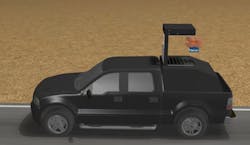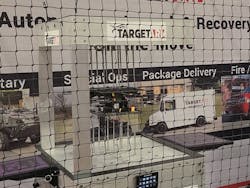Check out our AUVSI Xponential 2023 coverage.
Target Arm's VP and Lead Engineer, Ryan Bigham, shows off Tular, an autonomous Universal Launch and Recovery (ULaR) platform for drones. It can handle small drones of all types, including fixed-wing aircraft and quadcopters. The system can be mounted in vehicles that can then launch and recover aircraft while the ground vehicle is moving (Fig. 1).
The system works autonomously so that the driver of the vehicle doesn't have to interact with the launch-and-landing system other than to enable it. The system employs multiple metal rods tipped with a soft cup to launch, hold, and recover a drone (Fig. 2).
The rods retract when launching and raise up to capture the drone when landing. The position of the rods is adjusted automatically to hold the drone regardless of its position and orientation.
Links
The video transcript below has been edited for clarity.
I'm Ryan Bigham, I work for Target Arm. Our device is called Tular. It's a launch-and-recovery system that can be used on the move. So, think drone in a box, but it's a mobile platform. You can be driving or on a train or bus or anything you want, even an airplane. You can deploy our system, launch a drone, and then that drone, after it's done with its mission, can come back and be recovered all while still on the move.
You never have to stop. You never have to get out of your vehicle. In a dangerous situation like a convoy, you're driving through the desert or driving through the jungle, you can launch your drone without ever having to get out, ever having to leave the protection of your vehicle and still maintain the mission that you're on. Once the drone is done with your mission or it's getting low on battery, it can come back to the system and autonomously, without any cognitive load on the operator, be recovered.
So we're agnostic to the drone. We don't really care what drone you want to use in our system. The way that our system is designed is that the pins which capture the drone or recover and launch the drone can conform to whatever shape the drone is and whatever drone it is.
Let's say the drone is flying back into our system. It's a little bit off to the left or a little bit off to the right. Our system will sense that and only deploy the pins that will make contact with the drone where we want it to be.
Check out more of our AUVSI Xponential 2023 coverage.


